#coinage
Text


The long goodbye - Canada's 2023 coins still bore the Queen's image
#Queen Elizabeth II#Royal Canadian Mint#1 dollar coin#loonie#monarchy#coinage#currency#effigy#1952 - 2022#2023
21 notes
·
View notes
Text
Fun fact that, in Denmark, the National Museum has put together a reference collection of LARP (Live Action Role Playing) coins, because archaeologists started finding them in digs and got really confused!
One campaign, Legendernes Verden (World of Legends), minted 10.000 of their tin coins for a one-week LARP, and since they, and most other home-minted LARP coinage, use old Danish coinage terms on their creations, the confusion is both understandable and hilariously complete.
Here's an example:
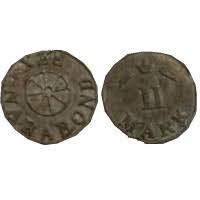
Those in the know would immediately recognise the inscription "Narabond" as a location withing the fictional Danish LARP world 'Niraham'. Those not in the know would be endlessly puzzled, as it looks perfectly reasonable for, for example, a medieval coin.
3K notes
·
View notes
Text
PINK and an Ancient Pun!
Our word pink seems to derive from the colour of the flowers we know as 'Pinks', specifically coming from their frilled edges and may come from German.
However, there are two words, one Greek and one Latin that give us very familiar English words.
We shall go to the Latin first. roseus means the colour of the rose, rosa, that is to say, pink, reddish-pink, or rosy. The rose is a favourite flower with many, including myself. It's pretty name comes from the language of the Romans.
The Greek word is related to the Latin rosa and you will notice the similarity between them: ῥοδος (rhodos). You may well be a fan of the lovely flower the rhododendron, which, yes, is commonly a pinkish-red. The name means 'red or pink tree'. In Homer the word ῥοδος forms a lovely adjective with δακτυλος (rhododaktylos), which the poet uses to describe dawn, capturing the lovely pink-reddish-golden colour of the sunrise sky.
Now, here is where the pun comes in. ῥοδος can also denote the flower the rose.
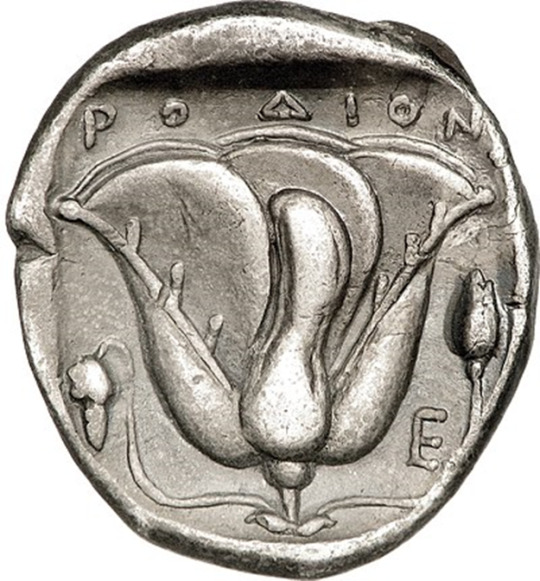
The lovely coin above shows a rose, a ῥοδος. You will have also spotted a word at the top which reads ΡΟΔΙΩΝ (ῥοδιων - rhodion). This tells you the people who minted these coin. Wait for it...(*drum roll*)...it was the Rhodians. The coin puns on the name of the people and the flower.
So, that concludes Cool Colours entry VII. Who knew you could connect the colour pink with ancient numismatic punnage? Wonderful!
#pink#red#rose#rosy#latin language#rhodos#rhodians#coinage#numismatics#ancient greek#derivatives#colours
267 notes
·
View notes
Text
Cleopatra VII Thea Neotera (51-30 BC), AE Diobol (80 Drachmae), Mint, Alexandria, between 50 - 40 BC.
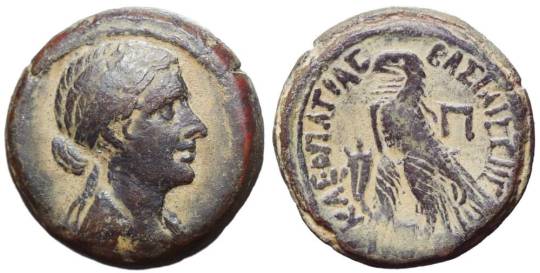
Ob. Diademed and draped bust of Cleopatra, left. Rev. Eagle standing left on thunderbolt; in left field, cornucopia and in right field, Π. Inscribed, KΛEOΠATPAΣ BAΣIΛIΣΣHΣ, right.
Cleopatra VII issued these coins when she was in her twenties. They were minted in Alexandria, Egypt, between 50 and 40 BC. They are all different because the minting process was manual.
Nevertheless, these are probably the ones that most accurately represent her.
32 notes
·
View notes
Link
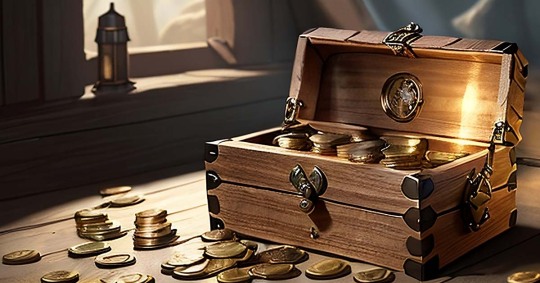
This is just a small tool I made to simplify your DnD and Pathfinder coinage. If there are any bugs please let me know either here or somewhere on my website like the comment section or the contact page.
I mostly made it for myself to help me out with my own character in a PF2e Westmarches campaign I am currently playing in, but I guess it doesn't hurt to share.
#tool#program#website#dungeons and dragons#d&d#dnd#pathfinder#pf2e#currency#coinage#gold#silver#platinum#copper#coins#treasure#ai art#ai image#stable diffusion#ai artwork#ttrpg
23 notes
·
View notes
Text
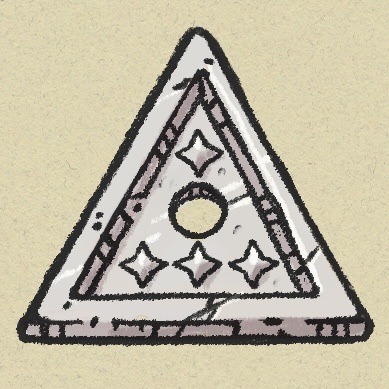
A Dungeons & Dragons silver piece. I like drawing coins, need to do it more.
#sketchbook#digital art#digital drawing#digital sketchbook#digital doodle#dungeons and dragons#dungeon master#dungeon loot#loot#coin#coinage#coin art#silver#drawing#art#sketching#sketchbook art
19 notes
·
View notes
Text

Superman and Wonder Woman
Commemorative Coin - Version 3 + Silver Metallic
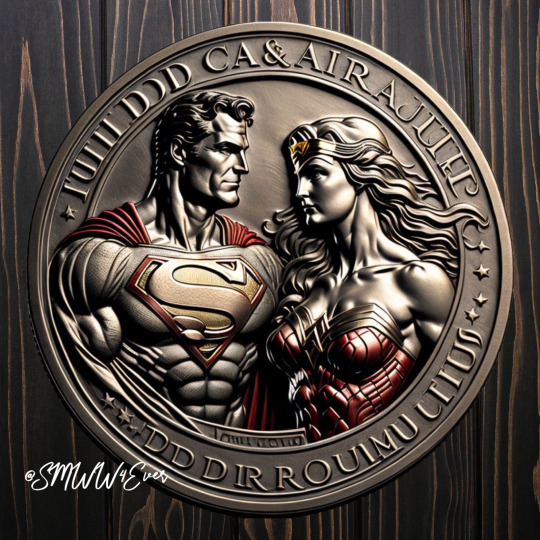
#superwonder#smww4ever#superman#supermanwonderwoman#wonderwoman#truelove#superman wonderwoman#lovebirds#powercouple#supermanxwonderwoman#coin#coinage#commemorative#kal and diana#diana and kal
11 notes
·
View notes
Text
Some women retailers were so well established that they issued their own coins – trade tokens to use as small change during the constant shortage of official coinage. Six trade tokens struck by women dating from 1660-70 have survived.

"Normal Women: 900 Years of Making History" - Philippa Gregory
#book quotes#normal women#philippa gregory#nonfiction#retailer#established#coins#coinage#currency#halfpenny#mary long#russell street#convent garden#60s#1660s#17th century
4 notes
·
View notes
Text
My New Coinage (Just Horsing Around)
The other day, I recalled that our word "fee" comes from the Old English feoh (cattle). It's a reminder that wealth was once measured by cattle in early Germanic cultures.
Inspired by this example, and not wanting to fall back on the usual D&D coinage of precious metals, I decided to base the currency in my fantasy on horses, which in other cultures is a sign of wealth. So now I have dobbins, the old clipped coins from a more rudimentary currency, and other denominations ascending from colt, cob, and stallion and ending with mares.
I knew those Old English classes I took in university would come in handy some day.
3 notes
·
View notes
Text
Little rant about modern fantasy currency. I get the whole use of copper, silver, and gold coins, wherever currency was spread or developed it ended up going for small disks usually of those materials until very recently, my problem is with the value, for fantasy authors seem to have no idea how much silver and ESPECIALLY gold are actually worth.
What am I talking about? Well, at the moment I'm writing, silver is 741 dollars per kilo and gold is 63,468 dollars per kilo. These are modern prices, of course, but it still means that back in the day, when a coin's value was based on their weight and purity of precious metal, they were still worth A LOT. As in, most commoners did their trade with COPPER, with silver being used very rarely outside professional merchants and only when they had to buy a lot of stuff at one time, (assuming they even HAD silver coins) and gold being used only by merchants, bankers, high-ranking nobles and monarchs for the largest transactions. A silver coin of good purity was what for a modern American would be a 20 dollar bill, and a gold coin was the THOUSAND dollar bills that got out of print and started being retired from circulation over fifty years ago because it was just that ridiculously excessive even for the large scale bank-to-bank transactions it was used for.
And yet in a modern fantasy work you find your average adventurer carrying hundreds of silver coins. In a certain fantasy work that I'd prefer not to name a large gold coin would be worth 5 British Pounds in 2001. Five pounds for a gold coin.
5 notes
·
View notes
Text
Antony's Noble Appearance

Ancient sources mention Antony’s physique as handsome and strong, and we can trace some consistent features of Antony’s physical appearance from sculptures and coins. At least some of these depictions can be said to reflect the charm of personality and his love of exhibitionism. Plutarch mentions that he had a noble appearance, a strong, well-trained body and a handsome face, which can be discerned from the portrait sculpture above. Coins do not usually give realistic detail of physical appearance, and generally the coins minted by Antony or in his honour show a strong face with regular features common to coin portraiture, as illustrated below.
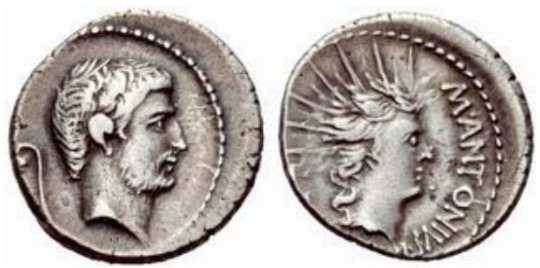
Denarius 42 BC, military mint (Italy) with bearded head of Mark Antony. On the reverse, the radiate head of Sol, with the legend M ANTONIVS III VIR RPC. This coin may have been minted to celebrate Antony’s victory at Philippi.

Ephesus, 39 BC. With the wreathed head of Mark Antony and the legend M ANTONIVS IMP COS DESIG ITER ET TERT (Octavia’s head is on the reverse).
Plutarch mentions Antony’s shapely beard, a feature not found on any of the sculptures, but illustrated on some coinage. It is Pollini’s contention (Raaflaub and Toher 1993, 341) that beardlessness invites the spectator to see Antony as a human in divine disguise. It is interesting to note that coinage often depicts Antony with beard while Octavian is instantly recognisable on coinage as young and beardless.
Sources: Plutarch's Life of Antony
Eleanor Goltz Huzar, Mark Antony - A Biography
#mark antony#marc antony#marcus antonius#octavia#coinage#coins#silver coins#rome#history#numismatics#ancient rome#roman history#roman republic#roman empire
13 notes
·
View notes
Text
Panamanian Quarter of Good Luck


It's not a particularly nice quarter, and it's not a nice round number of years old (43 tomorrow), but I found it in my loose change today, so it's a nice surprise for an amateur coin collector.
23 notes
·
View notes
Text
I like to think that the reason Lys puts its (unnamed) love goddess on its coins is to use the coins as a sort of silent advertisement for the city. If some or a large part of Lys’ economy depends on what Lyseni using modern verbiage might call sex tourism (which, obviously, in the context of Lys means the large-scale rape of enslaved people), then Lys needs outsiders to continue to associate Lys with the sort of luxury sex trade that the city is selling. A city that has a “love goddess whose naked, wanton figure graces [its] coinage” is obviously (or certainly at least publicly) a city that prioritizes sex and physical beauty above basically everything else. In turn, as these coins would circulate throughout Essos and even beyond - either as directly accepted currency or in the exchange houses of other major cities - those handling these coins would be reminded that Lys offers constant sexual pleasure (for those willing to pay for it, anyway, and certainly not for those people forced into sex slavery there).
45 notes
·
View notes
Text

If you arrange British coins this way, you'll get a shield — it represents the Royal Coat of Arms! 🇬🇧
(All coinage below £1)
2 notes
·
View notes